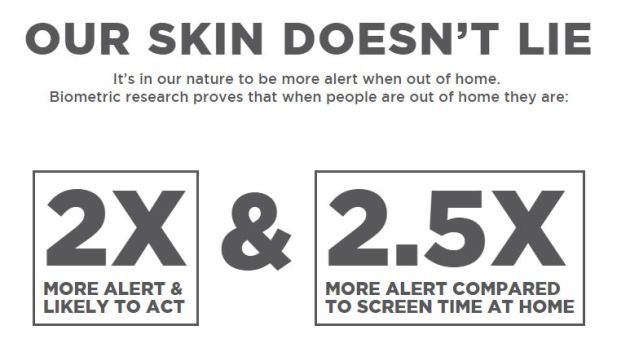
Consumers who are out of home are more likely to act on messages compared to inside the home, as a result of “primal” instinct, according to research from the Outdoor Media Association (OMA).
The study, conducted by the OMA's research partner Hoop Group, also found that consumers are two and a half times more alert out of home than they are during screen time - namely TV and social media - at home. They're also two times more likely to act on messages than when they're in the home.
Hoop Group used wearable technology to undertake the study using Galvanic Skin Response (GSR) which were attached to the hands of participants, as well as eye tracking glasses. This means that people's state could be measured within their natural environments.

The group also partnered with neuroscientist and honorary fellow at the University of Melbourne, Dr Phil Harris, to analyse the findings.
“The research shows we are more aroused when we’re out of home,” Harris says. “We’re wired to scan the environment for events that can impact on us or things that are linked to our goals. There’s more to react to, therefore we’re more likely to act.
“It’s a primal thing – survive and thrive. This is important news for marketers as we know arousal drives attention and memory encoding, both of which are key factors that underpin advertising message impact.”
Think TV CEO Kim Portrate had her tongue firmly in her cheek saying: “I think it’s great to know people are alert when they leave home although I was a bit concerned for the 2/5th of the population potentially put themselves in harm’s way when they head out into the world.”
She adds: “With regard to the claims in the research, I think marketers want information about what the return is for their media investments. Previously reported studies – and there is a significant body of work on ROI - provide evidence that TV remains the most effective media for delivering ROI.”
The study forms the basis of a trade campaign called 'The Primal Advantage' which launched yesterday.
OMA CEO Charmaine Moldrich says the research proves the power of the channel.
“We already know that out-of-home is a very powerful channel for reach, proximity, flexibility and interactivity, and now we know that the out-of-home environment has an inherent ‘kick’ over media consumed indoors: An audience that is twice as switched on and likely to act on ad messages,” she says.
Have something to say on this? Share your views in the comments section below. Or if you have a news story or tip-off, drop us a line at adnews@yaffa.com.au
Sign up to the AdNews newsletter, like us on Facebook or follow us on Twitter for breaking stories and campaigns throughout the day.


